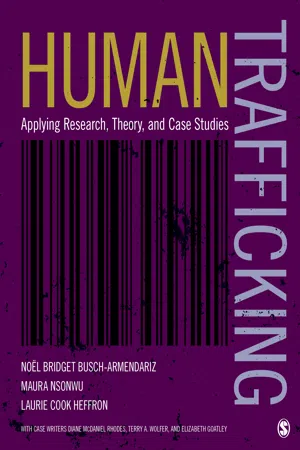
Human Trafficking
Applying Research, Theory, and Case Studies
- 352 pages
- English
- ePUB (mobile friendly)
- Available on iOS & Android
Human Trafficking
Applying Research, Theory, and Case Studies
About this book
This practical, interdisciplinary text draws from empirically grounded scholarship, survivor-centered practices, and an ecological perspective to help readers develop an understanding of the meaning and scope of human trafficking. Throughout the book, the authors address the specific vulnerabilities of human trafficking victims, their medical-psycho-social needs, and issues related to direct service delivery. They also address the identification of human trafficking crimes, traffickers, and the impact of this crime on the global economy. Using detailed case studies to illuminate real situations, the book covers national and international anti-trafficking policies, prevention and intervention strategies, promising practices to combat human trafficking, responses of law enforcement and service providers, organizational challenges, and the cost of trafficking to human wellbeing.
Frequently asked questions
- Essential is ideal for learners and professionals who enjoy exploring a wide range of subjects. Access the Essential Library with 800,000+ trusted titles and best-sellers across business, personal growth, and the humanities. Includes unlimited reading time and Standard Read Aloud voice.
- Complete: Perfect for advanced learners and researchers needing full, unrestricted access. Unlock 1.4M+ books across hundreds of subjects, including academic and specialized titles. The Complete Plan also includes advanced features like Premium Read Aloud and Research Assistant.
Please note we cannot support devices running on iOS 13 and Android 7 or earlier. Learn more about using the app.
Information
1 A Primer to Human Trafficking: Understanding Scope and Dimensions
Slavery is a fundamental abuse of human rights and a major obstacle to social justice. It is an affront to our humanity and it has no place in the twenty-first century. And yet [45.8]1 million women, men and children are still trapped in forced labor all over the world, generating USD 150 billion in illicit profits for those who exploit them. There should be no need for the International Day for the Abolition of Slavery to exist. However, each day, men, women and children are tricked or coerced into abhorrent situations including bonded labor, prostitution and exploitative domestic work. Global commitment to combating modern slavery has increased but current responses still fall far short of addressing the entirety of the challenge or its root causes. Ending modern slavery requires strong legislation, strict implementation, joint commitment of countries and social partners, along with effective support systems for the victims.—Guy Ryder2Director-General of the International Labour Organization (ILO)December 2, 2015[Trafficking in Persons and Work Exploitation Task Force Complaint Line 1.888.428.7581][Trafficking Information and Referral Hotline 1.888.373.7888]
1. Learning Objectives
- 1.1 Students will examine a broad scope of human trafficking as a human rights problem in the United States and globally.
- 1.2 Students will be introduced to the definition of human trafficking, including various forms of exploitation for profit and modern forms of slavery-like practices in the United States and around the globe.
- 1.3 Students will appreciate the historical underpinning of modern-day slavery.
2. Key Ideas
- 2.1 A human rights perspective has been widely used as a thoughtful framework for understanding and addressing human trafficking.
- 2.2 The lack of a holistic and agreed-upon definition of human trafficking has made estimating the scope of the problem challenging in the United States and globally.
- 2.3 Push-pull factors, rather than country culture, are better explanations for the modern exploitation of people.
Chapter Overview
3. Decision Case
The Tale of the Paleteros3
The Austin, Texas, Division of the U.S. Department of Labor
Nicole
Table of contents
- Cover
- Half Title
- Publisher Note
- Title Page
- Copyright Page
- Brief Contents
- Detailed Contents
- Preface
- Acknowledgments
- About the Authors
- Section III A Holistic Approach to Understanding Human Trafficking
- 1 A Primer to Human Trafficking: Understanding Scope and Dimensions
- 2 Understanding the Context of History
- 3 Understanding Terms, Definitions, and Intersectionality
- 4 The Economics of Human Trafficking
- Section II A Holistic Approach at Micro, Mezzo, and Macro Levels
- 5 Understanding, Disruption, and Interventions at the Micro Level
- 6 Understanding, Disruption, and Interventions at the Mezzo Level
- 7 Understanding, Disruption, and Interventions at the Macro Level
- Section III A Holistic Approach to Taking Actions
- 8 Understanding Collective Impact and Individual Action
- Appendix A 2015 NHTRC Annual Report
- Appendix B Survey to Assess Student Knowledge Regarding Human Trafficking
- Appendix C Human Trafficking Video Resources
- Appendix D Syllabus for Undergraduate Modern-Day Slavery Course
- Index